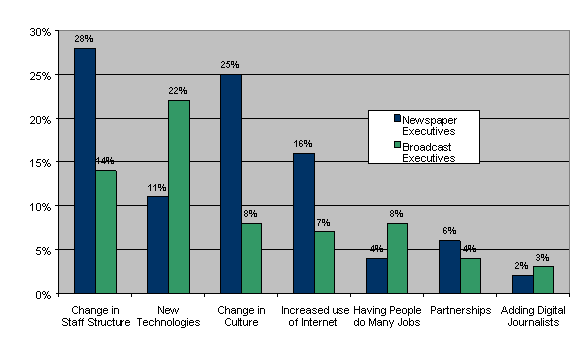Without significant new revenue streams, how long would their news operations remain viable? In all, nearly a third (31%) said their news organizations are at risk in five years or less (7% in two years or less and 24% in three to five years). Another 17% put the number up to 10 years. But most, 46%, of those surveyed were confident that their organization would be around more than 10 years from now.
And is there any difference between those news operations with newspaper roots versus those with broadcast legacies? Not really. In that regard, the notion that somehow newspapers are in greater peril than television is not supported by the data, or at least not believed by the news executives who run the organizations.
How Long Do You Think Your News Organization Can Remain Solvent?
(Newspaper Executives)

How Long Do You ThinkYour News Organization Can Remain Solvent?
(Broadcast Executives)

How Long Do You Think Your News Organization Can Remain Solvent?
(All Executives)

Among newspaper organizations, more than nine out of ten (92%) said they had cut back on news staff in the last three years. Among broadcasters surveyed, the number was 59%. Only 10% of all respondents said that they added news staff in the past three years, and far more broadcasters (15%) said they added news staff, compared to only 2% of newspaper executives.
Staffing Changes in Last Three Years

Question: “In the last three years, has your organization cut back on its news staff, added news staff or has the news staff remained about the same?”
The cuts were deep, but especially at newspapers. A third of newspapers that had cutbacks (33%) said they saw declines of one-quarter to half of their staff. Most news organizations saw smaller, yet still significant, staff decreases; 45% of newspapers faced cuts of 10-24% and 53% of broadcasters saw the same.
Size of Staff CutbackS

Question: “How large was the decrease in your news staff?” Based on those whose news organization had staff cutbacks.
But despite the cutbacks, there is a sense of determined optimism among news organizations. Two-thirds say that their staff is “leaner than ideal, but that they can still do the job well.” Only 20% of news organizations said their staff is too small to do more than the bare minimum of reporting. And these views are consistent across broadcast and newspaper-based operations.
On the other hand, only 8% offered the most confident assessment, that “our staff is now plenty big to do the job.” Any notion that news staffs had gotten bloated and the cutbacks now just take them to where they should be—that this cutting was just fat and not bone, as it were—is not widely shared.
Effects of Staff Cutbacks

Question: “Some people say their news staff had gotten larger than necessary and with cutbacks is still big enough to provide robust coverage. Others believe the cutbacks have materially hurt their ability to do their job. Thinking about your own organization, which of these statements comes closer to your view?”
The survey also tried to probe more deeply to identify the reasons for the optimism in newsrooms. What was different in their operations that was helping them do their jobs better than before? The findings here, particularly in newspaper-based newsrooms, had more to do with changing the culture of their newsrooms than with the adoption of new technology, though clearly the two subjects are related.
Overall, about a quarter of newspaper executives mentioned changes in staff structure and leadership as well as changes in newsroom culture as the most helpful new development in covering the news.
One dimension of the sense of changing culture that came through in many responses was a clearer sense of purpose or focus.
“Clarifying the mission,” wrote one newspaper executive. “Clearer focus,” wrote another. “Focus on priority topics,” wrote a third. “We have been forced to focus like a laser on what we can do well and not worry about the rest,” wrote still another.
This new focus took various forms. Some mentioned renewed emphasis on watchdog and enterprise work. Others described concentrating more on breaking news. And others mentioned engagement with the audience, both from user generated content and responding more to consumers’ comments. That suggests that with limited resources, people are striking out in different directions. It is not clear if all will succeed.
But there was a clear sense that the financial crisis facing legacy media had inspired creativity. That tone far outweighed the number of comments that seemed simply angry or downbeat.
“The decline in readership and revenue has removed any sense of complacency and much of the hubris. Some of the poor performers are gone. Pace of reporting and publication has quickened. We are more open to collaborating with our audience,” wrote one newspaper executive.
“The reduction in staff and subsequent reorganization FINALLY convinced everyone we are serious about a Web-first operation,” wrote another newspaper news executive. “Our capacity for covering breaking news is stronger than ever. We fully integrated with our broadcast partners.”
And executives spoke enthusiastically about new hires, younger people, versed in multimedia. Some wished they had moved faster to bring such people in.
Among broadcasters, the No. 1 change that people cited favorably was adopting new technology that did not involve the Internet. Many of these praised in particular the impact of so-called “one-person bands,” in which a single person is equipped with the skills and equipment to report, shoot video, do live feeds and record audio—the correspondent, producer, camera and sound crew in one.
“The one-person-band outfits allow the survivors of the cutbacks (the best qualified remain behind) to gather news effectively and quickly,” said one broadcaster. “Reporters who shoot and edit their own stories,” said another. Wrote a third, these crews “give us more cameras and reporters on the street everyday.”
What Change in Your Newsroom Has Helped Coverage?

Few found Internet resources helpful to covering the news. Only 16% of newspaper executives said that adoption or increased use of Internet resources were helpful in covering the news and only 7% of broadcasters agreed.
“We are expected to do more with less and that hurts morale,” one broadcaster explained.
“Requiring me to basically do three jobs—producing, videography and editing when I was hired to do one—producing,” offered another broadcaster when asked what if any changes made the job more difficult.
“I have one reporter per shift a day,” said another, “I have one photographer on staff. He is our only live truck operator. Our company dropped the AP News Wire Service about the same time they cut the staff.”
“Fewer reporters,” said one newspaper executive; “cutting positions,” wrote another; “too many cuts, too much talent leaving the business,” wrote a third.
Far fewer felt that smaller budgets had a negative affect on news coverage. Only 14% of respondents said that budget cuts hurt their organization’s ability to cover the news.


